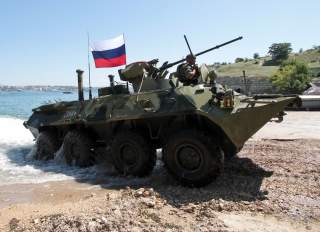Why Russia's Navy Just Can't Compete With America's Anymore
Falling behind.
Key point: Moscow just can't afford the cost of keeping up with Washington. Moreover, Russia is predominantly a land power and does not have experience succesfully building supercarriers.
Russia’s Navy is falling behind the U.S. Navy in combat power, according to Russian defense press.
The Russian Navy’s combat capability was just 45 percent of the U.S. Navy’s according to an analysis by flot.com, a Russian defense Web site [English translation here]. This is down from 47 percent in 2017 and 52 percent in 2014.
Exactly how these metrics were calculated isn’t clear, but it appears the United States is ahead in the rankings because it is building bigger ships than Russia is. In theory, 2018 should have been a good year for the Russian Navy, which received seven ships, including the powerful frigate Admiral Gorshkov. “Compared to the almost failed year of 2017, when the Russian Navy received two warships and an icebreaker, the past year was productive for domestic shipbuilding,” flot.com noted.
The problem is that other than the Admiral Gorshkov, the other new vessels were smaller craft including a corvette, a patrol ship and a gunboat. “One would expect that the position of the Russian Navy in the ranking will be strengthened,” flot.com said. “However, instead, the result was 2 percent less than last year. This is due to the fact that most of the new ships of the Russian Navy, with the exception of the Admiral Gorshkov frigate, belong to the class of small rocket ships and coastal ships, which have a [statistical] weight coefficient of 1 unit. Meanwhile, the U.S. shipbuilding industry last year transferred to the fleet two missile destroyers of the Arleigh Burke-class (a [statistical] factor of 3 units) and a pair of multi-purpose Virginia-class nuclear submarines (a factor of 5 units).”
Flot.com isn’t expecting things to get better. “Arguing about the prospects of the Navy for 2019, one can hardly expect a change in the emerging trend: out of large orders that the fleet should receive, the second frigate of the project 22350 ‘ Admiral Kasatonov ‘ (3 units) and the first modernized multi-purpose submarine of the project 885M Kazan (5 items). The remainder will be corvettes, coastal warfare ships and support craft.”
In contrast, “American shipbuilders annually hand over 2–3 destroyers of the class ‘Arleigh Burke’ and the same number of submarines of the ‘Virginia’ type,” flot.com said. “In addition, in 2019, the U.S. Navy had already commissioned the second Zumwalt-class destroyer Michael Monsour (3 units). Let's not forget about the American program of building ships of the coastal zone of the LCS class, which has reached the pace of at least three orders over a year.”
What’s really ironic here is the mirror-imaging, where one side sees the reverse of what the other sees. During the Cold War, both America and the Soviet Union spent vast sums to acquire more and better weapons in the unshakeable belief that the other side was pulling ahead in the “Missile Gap” and other marathons in the arms race.
Today, the U.S. Navy argues that it lacks enough ships to perform its missions, such as preparing for war with China or Russia. Its admirals worry about new threats such as hypersonic Russian and Chinese anti-ship missiles. But to Russia, whose navy can only envy America’s fleet of eleven giant aircraft carriers, the enemy must seem powerful and well-funded indeed.
The U.S. Navy sees its glass as half-empty. But to Russian observers, the American navy’s cup runneth over.
Michael Peck is a contributing writer for the National Interest. He can be found on Twitter and Facebook. This first appeared in 2019.
Image: Reuters

